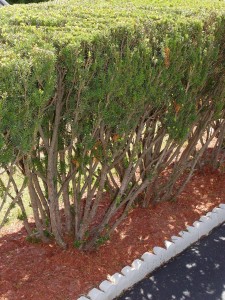Hedge Edge
May 8th, 2012
We’re hitting the time of year now when a lot of chainsaw-toting guys head out to “prune” the landscape.

Shear a juniper back into bare wood and it'll stay bare, as has happened to the bottom of this poor juniper.
Despite what you may see even at the hands of pros, not all plants take kindly to shearing. This kind of cutting can destroy the natural form of archers and weepers and cause weak, stubby growth on others.
But even for chop-amenable species, there’s a right way and a wrong way to hedge.
I sat in on a program on this by Roger Davis at last year’s Woody Plant Conference at Scott Arboretum. Davis prunes the amazing topiary yews at Longwood Gardens.
His top bit of advice is to start young and keep at it regularly.
“Hedge maintenance begins on Day 1,” says Davis. “It’s a training process, not something you do 20 years down the road. Don’t wait until the hedge is halfway over the walkway to start pruning. Hedges are like children. You have to start early.”
If you whack back into bare wood, some species (like yew, hemlocks, hollies, privet and boxwoods) will push out new growth — although they’ll look butchered for awhile.
Do that to others (fir, juniper, spruce and arborvitae, for example), and you’ll permanently deform them — or worse.
Davis advises cutting back only enough to remove the new growth, or nearly so.
For bigger-leafed evergreens (cherry laurel or rhododendrons, for example) or if you like a somewhat informal look, use pruners. The job will take a lot longer, but you’ll do less leaf damage.
For that formal, sculpted look, use shears — power ones or old-fashioned hand-operated ones.
Davis uses a 3-step shearing plan.
Step 1 is a rough cut to get rid of new growth.
Step 2 is a slow cut to even out bumps and divots.
Step 3 is a smooth finish cut.
“Take it nice and slow,” he says. “It takes longer this way, but you get a better result in the end.”
Whatever tool you use, keep it sharp. Clean snips heal better and brown less.

Shear to a vase shape and your hedges will get bare at the bottom as the top foliage shades the lower.
Remember, the idea is to cut the foliage, not to tear or rip it off.
Also very important to keep any evergreen hedge from getting bare at the bottom — taper it out so the bottom is wider than the top, not vice versa as so many chainsaw-toters do.
A vase shape causes the top to shade the bottom branches, and that’s why the bottoms get bare.
Davis suggests a taper that goes out 1 to 2 inches for every foot of height.
And one other trick for keeping a hedge dense and healthy — open up a few holes to let sunlight into the plant.
For taller hedges, Davis cuts a few evenly spaced holes in the top. No one sees them anyway.
All hedges also should get a few small openings at regular intervals in the sides to let in light that encourages more interior growth.
“Openings let the snow fall through, too, and so you get less winter damage,” Davis adds.
Most of your serious hedge-pruning should be done in spring with one or two neatening cuts in summer.
Knock it off by late summer, and let your hedges get ready to go into dormancy in fall.







